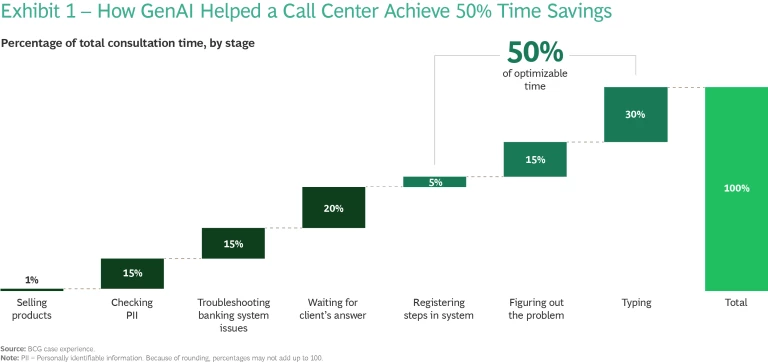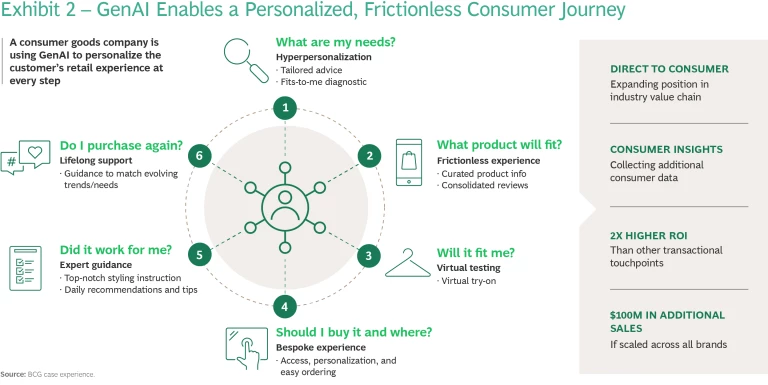In the twelve months since ChatGPT was launched, most of us have experienced a “wow” moment with generative AI —a moment when its capabilities seemed like magic.
Executives have been wowed, too. But after a year of hearing about the wonders of GenAI, they’re ready for it to deliver real-world results—and soon. CEOs are asking some hard questions: Which opportunities offer the highest value? What are the tradeoffs between cost, benefits, and risks, and how can companies ensure that GenAI is deployed responsibly ? How do I prepare my organization for the enormous changes this technology will bring?
In short: How do companies turn GenAI’s ability to deliver unexpected, impressive performance—its magic—into equally impressive business impact?
To help answer these questions, BCG spoke with over 2,000 CEOs and C-suite executives to get their take on the effectiveness—and limits—of generative AI. We’ve learned a great deal about how companies are using this remarkable technology. And with a year’s worth of experience and experimentation under our own belts—and as new and even more impressive GenAI models arrive every month—we’d like to share our perspective on how to turn GenAI’s vast potential into lasting value.
Deploy, Reshape, Invent
No single approach can capture the full scope of what GenAI offers. Instead, executives should evaluate their opportunities across three broad value plays:

These plays aren’t just nifty, small-scale pilots meant to satisfy investors or boards. They involve an organization-wide commitment to embedding generative AI into every area, including budgets, processes, roles, and culture, while following the principles of responsible AI . And while the plays can be initiated simultaneously, each comes with its own productivity outcomes, cost-benefit tradeoffs, requirements for success, risks of unintended consequences, and implications for operating models. Let’s take a closer look.
Deploy GenAI in Everyday Tasks
Generative AI is already bringing welcome changes to the day-to-day work experience. Employees can use GenAI-enabled assistants to create emails and presentations much more quickly. Automated tools can deftly summarize meetings and calls in a matter of seconds, freeing up time for more creative, value-added work.
But the changes don’t end there. Software providers are marketing increasingly compelling solutions that boost everyday effectiveness with email categorization and more precise customer engagement. You’ll find that widely deploying diverse GenAI solutions and models will give productivity a jolt. And not just for individual workers—GenAI tools can quickly deliver broad, diffuse productivity gains of 10% to 20% or more across the enterprise.
To set the Deploy play in motion, companies should do the following:
Get started now. Technology wise, deploying GenAI is the most straightforward of the three plays. You can begin right away by leveraging off-the-shelf software; teams can easily upgrade workspace tools that they already use. You’ll want to set clear guidelines for deployment, especially around confidentiality, data privacy, and intellectual property ownership. And don’t go light on testing, which is critical to selecting the best solution for a specific task—once a tool is deployed across tens of thousands of employees, it becomes harder to change course if the fit isn’t right.
Don’t fear the challenge of large-scale adoption—embrace it. Massive upskilling is essential to delivering broad efficiency gains from GenAI. Win the hearts and minds of employees with an upskilling program that conveys how fundamental the technology is to their effectiveness and longer-term personal growth—and to the company’s success.
Carefully evaluate the costs and benefits of deployment. GenAI may mean lower costs—or maybe not. As transaction costs are distributed over a scaled hosting model, the per-unit cost of each transaction will go down. On the other hand, licensing carries a fixed cost structure that may lead to higher costs as usage grows.
Still, deploying GenAI is a table-stakes call in today’s competitive environment. You’ll want to optimize other costs to make up for the expenses—but for those who choose the right opportunities, the immediate gains will be worth it.
Reshape Critical Functions
While deploying GenAI tools for productivity is a must, it’s not enough. Even more substantial opportunities are within reach when organizations reshape processes and functions.
The gains of the Reshape play show up where you’d expect—customer service, marketing content, software development—but also in unexpected areas like field services and engineering. Though reshaping functions can pose challenges for an organization—including the centralization of tasks and process reengineering—you can’t ignore the payoffs. Generative AI can deliver 30% to 50% efficiency and effectiveness gains.
In a call center, such gains can mean that everyone wins—customers, employees, and the company. BCG helped a bank’s call center reduce the duration of its customer-service consultations by nearly 50%. (See Exhibit 1.) The GenAI tool involved was not only effective, but user friendly: agent feedback on the copilot solution included a 75% approval rating. Busy workers love this kind of efficiency—as do customers.

Companies making the “Reshape” play should keep the following in mind:
Anticipate the impact on your workforce. Individual tasks and responsibilities will shift as generative AI becomes integral to business units; for instance, copywriters on a content marketing team will begin to focus more on editing GenAI outputs. But the demands of a move to GenAI are extensive. You’ll need to create new roles and reallocate budgets. And performance assessments must also reflect GenAI usage.
Combine generative AI with predictive AI and proprietary data. Job-centric AI assistants are handy assets when they bring together GenAI with machine-learning systems and other traditional AI tools, also known as predictive AI. For example, an integrated AI assistant for field-maintenance workers would use a predictive model, based on a wealth of proprietary data, to anticipate failures and direct crews to the right repair sites; the same assistant would also use a generative AI model to provide on-the-spot knowledge and repair procedures.
A client is using this type of combined model to achieve a 30% reduction in repair times. The client’s field workers are more productive—and their equipment is functioning better.
At BCG, we’re seeing the value of bringing predictive and generative AI together, not only for internal tools for employees but also in our solutions for clients. BCG’s Fabriq marketing platform relies on both types of AI to power personalization programs, using predictive AI tools for product selection and experimentation along with GenAI solutions to support campaign automation and high-volume content creation.
Our experience with Fabriq underscores a broader point: the strategic value of integrated AI is real and measurable. We’ve seen striking results for clients even in regulated industries like health care, banking, and fintech: 40% more engagement, 80% increases in account creation, and 30% improvements to customer recommendation scores.
Regardless of your industry, you should strive for simplicity when integrating GenAI with other AI tools by avoiding duplicate point solutions—and you should also provide high-relevance, accurate output to users by preventing hallucinations. You’ll also want to balance cost and stability to optimize the time a solution takes to answer a query. A fast-paced process of development, where business and technology teams regularly share feedback on model performance, will help your organization build a solution well-suited to your needs.
Business and functional leaders should steer the play. These leaders will define a target vision for the company’s use of AI. They’ll establish guardrails and guide a series of pilots across multiple parts of the organization to identify what works. And they’ll devise a systematic plan to scale up the most effective pilots.
But leaders should watch out for the dark side of GenAI’s magic—the risks linked to unintended usage, hallucinations, and false precision, for example. And there are risks to productivity as well: using generative AI for the wrong task is a great way to destroy efficiency. A large-scale BCG study found that workers who used GPT-4 for a task outside the technology’s frontier of competence performed worse than those who didn’t use the tool.
Experimentation can pinpoint where the technology is most effective. It can also help you find the places where people can complement machines, either through human-in-the-loop feedback models or by taking over the last mile of a process that cannot be fully automated. Your staff is a big part of the Reshape play, which only reaches full effectiveness when an organization focuses most of the effort—about 70%, based on our 10-20-70 rule —on people.
Invent New Business Models
Generative AI is about more than increasing productivity. It can help you reinvent customer experiences, create new services and offerings, and even build new business models.
Businesses are pursuing ambitious revenue gains from GenAI. A financial information company is using the technology to turn its core product—selling financial data and analysis—into a conversational insight-generation platform for clients. This offering alone is targeting up to $100 million of incremental, net new revenue. The company’s entire set of GenAI offerings will transform its revenue profile and add significant enterprise impact.
In another example, a consumer goods company is building a GenAI-powered conversational assistant to provide customers with personalized diagnostics, trend discovery, product recommendations, and virtual try-on services. The company is just now starting to explore many new direct-to-consumer interactions—interactions that may take a bigger role in the overall value chain. (See Exhibit 2.)

Two additional observations about the Invent play:
Big-time engineering gives you the right level of performance. This value play is the most complicated, technology wise, and you’ll want to build custom systems for reliability and cost efficiency. But your design thinking also needs a strong customer-centric emphasis to build the right offering that will generate market traction. The example shown in Exhibit 2 uses a set of four different large-language models, ten databases, and custom logic to deliver the desired user experience.
Compared to the prior two plays, the Invent play has limited implications for the overall workforce. Small, dedicated incubation teams—fast-moving, nimble—are ideally sized to invent new models. Once a model begins delivering value, you’ll know what staffing needs to worry about as the project is scaled.
This play promises the greatest long-term competitive advantage. To achieve that advantage, develop models that draw on your first-party data and intellectual property. These unique assets are fuel for trailblazing GenAI experiences; use these assets to create interactions that customers can’t find anywhere else.
Delivering GenAI Value
The Deploy, Reshape, and Invent value plays are not mutually exclusive. You’ll get more from GenAI by balancing initiatives across all three plays. Put in place the specific technology backbone and responsible AI policies for each, and get your people excited about each initiative—there’s no magic without them, after all.
Accelerating the Journey
Companies in all sectors are moving fast to realize meaningful gains through generative AI. Executives should use this one-year mark as an impetus to accelerate their organization’s journey. Here’s how to get started:
- Establish a solid foundation. Create a secure environment for the company to grow its exploration of GenAI. Develop training, guardrails, and cybersecurity practices to drive safe, responsible, and informative experimentation.
- Prioritize your value plays. Strive for a balanced portfolio of initiatives across the Deploy, Reshape, and Invent plays to lock in table-stakes requirements, find short-term productivity gains, and reach for lasting competitiveness.
- Steer the organization to the best ways to realize value. Focus on the best opportunities to link GenAI with positive results. Avoid getting lured in by flashy GenAI functions that don’t align with specific business objectives.
- Accelerate enterprise learning. Invest in coordinated experimentation at both the local and global levels. Given the speed of GenAI’s evolution, companies can’t afford to have disparate teams embarking on their own individual learning journeys. Continuous, widespread learning is the best way to keep in step with the latest capabilities, and teams throughout a business should share what they learn as often as possible.
- Envision your organization’s future advantage. Eventually, the playing field will normalize; every company throughout a sector will implement generative AI tools, and some competitive advantages that a business enjoys today will grow less pronounced. But GenAI will also offer new advantages as it continues to evolve—especially data-quality superiority, speed, and agility. Anticipate where the most promising opportunities will be over the next three to five years and begin factoring these areas into your learning roadmaps.
New technologies that once seemed magical—the lightbulb, the smartphone—quickly became essential. Generative AI will likely be just as transformative, particularly when combined with other forms of AI. Businesses are already moving forward with implementations for competitive advantage, so don’t hesitate. Greater productivity and impressive new revenue streams—not to mention long-term competitive advantage—will go to the organizations that can put GenAI’s magic to work today.





















